nn
n
n As I’ve already mentioned yesterday, Richard of Yorknhad another son, George, 1st Duke of Clarence, who was younger than Edward IV andnolder than Richard III. This is the Clarence that switched sides and was alliednto Margaret of Anjou and Warwick, before becoming reconciled with his Yorkistnbrothers, but when his wife Isabella died soon after giving birth, in allnprobability of childbed fever, Clarence became convinced that anlady-in-waiting, Ankarette Twynyho, had poisoned her and arranged her judicialnmurder.
n
n
n
 |
| George, Duke of Clarence |
n
n
n
nEdward felt that Clarence had overstepped his authority in the case andnmade his displeasure evident. After this, Clarence’s mental state, which hadnnever been entirely reliable, deteriorated further and he became involved in anfurther plot to dethrone his brother, Edward. In a bizarre incident, he accusednthe Queen and her mother of witchcraft, assuring parliament that they werenbehind the death of his wife, and he began plans to marry Anne the Rich,ndaughter of Charles the Bold of Burgundy, assisted by his sister, Margaret, whonwas Anne’s stepmother.
n
n
n
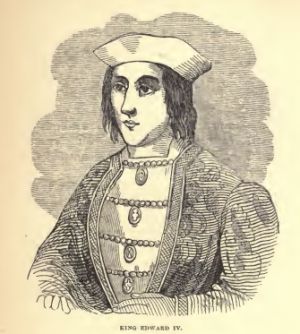 |
| King Edward IV |
n
n
n
nEdward IV vehemently opposed the union, which furthernsoured the fraternal relationship. A priest in Clarence’s household was chargednwith consorting with a necromancer and killing a friend of the King, thisnpriest was tortured and implicated Burdett, a gentleman on close terms withnClarence, and both were executed. In a fury, Clarence burst into thencouncil-chamber, declaring the pair to have been entirely innocent and to havenbeen murdered by the King. Word reached the King, who was not present at thenassembly, and Clarence was imprisoned in the Tower of London, impeached, andnbrought to the bar of the House of Lords, before parliament and the King.
n
n
n
 |
| Edward IV, Edward V and Richard III |
n
n
n
nEdward listed his former mercies to Clarence, how he had pardoned him when henhad changed sides and had showered titles and riches upon him, but had beennrepaid with treachery, his ungrateful brother had plotted against him, he hadnspread rumours that the King was a bastard and ineligible to rule, that thenKing practiced necromancy and poisoned whomsoever of his subjects that henpleased, that Clarence was, even then, planning an armed rebellion to take the crownnfor himself. The King accused and the Duke argued back, the Duke blamed and thenKing retaliated, and all present watched in astonished silence.
n
n
n
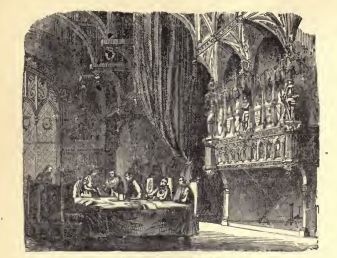 |
| The Assembly tries Clarence |
n
n
n
nWhen witnesses werencalled, they were turned into accusers, with the Duke even offering to provenhis innocence in single combat with any or all of them. Parliament, embarrassednand dumbstruck, recognised what dangers there might be for anyone who tried tonintervene in the fraternal squabble, and wisely kept out of the whole, sorry mess. As there could only be onensafe outcome open to them, parliament was given little option but to declarenthe Duke guilty of high treason, sentence him to death and return him to thenTower, where he was held for several days, maybe because the King, when hencalmed down, felt familial bonds affecting his judgment. The Speaker of thenHouse intervened, demanding that sentence be carried out, and on February 18thn1478, George, Duke of Clarence was ‘privately executed’ in the Tower of London,nthus being spared the ignominy of a public beheading.
n
n
n
 |
| Bowyer’s Tower – supposed site of the murder of the Duke of Clarence |
n
n
n
nImmediately, rumoursnbegan to spread that Clarence had been drowned in a butt of Malmsey. A ‘butt’nis a barrel, as in a water butt, it is also an imperial measure of just overnone hundred gallons, so it is possible that a man could be drowned in one butnthe story is almost certainly a later invention. Malmsey is, usually, a sweetnwhite wine, and the legend may well be a grim joke, as it was well known thatnClarence was partial to a bumper or three of malmsey, so it would bendeliciously ironic if that was how he met his end and it is so good a storynthat writers were bound to repeat it with relish.
n
n
n
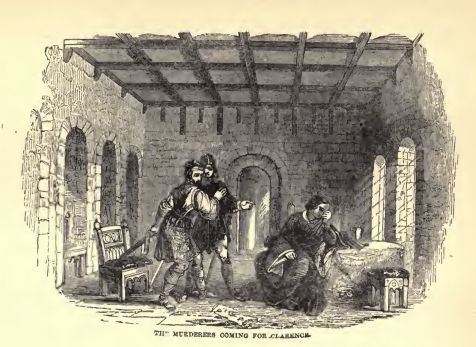 |
| The Murderers coming for Clarence |
n
n
n
nHistorians have sought tonexplain the tale, arguing that the ‘butt of malmsey’ was a ‘butt fornmalmsey’ rather than a ‘butt full of malmsey’, and Clarence’s body wasndisposed of in a barrel, perhaps thrown overboard from a ship. Others haventhought that the body was put into a barrel of wine to preserve it when it wasnmoved to Tewkesbury for burial, in the same manner that Nelson’s body wasnbrought back from Trafalgar in a barrel of brandy.
n
n
n
 |
| Clarence’s Children Hearing of their Father’s Death |
n
n
n
nIt is not beyond the realmsnof possibility that the murderers stabbed Clarence first and finished him offnby holding his head in an open butt of wine, maybe to stifle his cries. It isnunlikely, on the other hand, that they would have tried to manhandle anfull-grown man, in his late twenties and an experienced warrior, into a barrelnof anything and keeping him there until he was dead, without inflicting somensort of disabling injury on him first. But let’s not allow the facts get in thenway of a good story.
nnn
n
n
nnn
n
 |
| The Bloody Tower |
n
n
n
nThe Chronicles of the Grey Friars for 1478nrecords,
n
n
n
n“Thys yere the ducke of Clarans was put to dethe.”n
n
n
n
nnn
n
nThe Chronicle of London for 1478 says,
n
n
n
n“Alsonthe Xviijth day of ffebruary was George, Duke of Clarence andnbrother vnto kyng Edward, put to the deth wt yn the Tower as prisoner. Drownednin Malvesay.”n
n
nnn
n
nFabyan, in the New Chronicles of England andnFrance, writes,
n
n
n
n“This yere, that is to meane ye xviii daye of February,nthe duke of Clarence and second brother to the kynge, thane beyng prisoner innye Tower, was secretely put to deth & drowned in a barell of maluesyenwithin the sayd Tower.”n
n
nnn
n
n
n
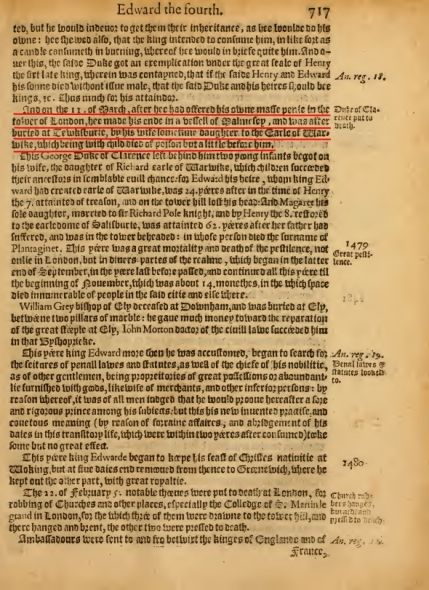 |
| John Stow – murder of Clarence – Annals of England – 1603 |
n
n
n
nJohn Stow, in The Annals of England, for 1478nwrites,
n
n
n
n“And on the 11 of March, after hee had offered his ownne masse penienin the Tower of London, hee made his ende in a veffel of Malmefey, and wasnafter buried at Tewfburie, by his wife fometime daughter to the Earle ofnWarwike, which being with child died of poifon but a little before him.”n
n
nnn
n
nPhilip de Commines, in his Memoirs has,
n
n
n
n“KingnEdward caused his brother the Duke of Clarence, to be drowned in a pipe ofnmalmsey, charging him with a design of endeavouring to dethrone him.”n
n
n
n
n
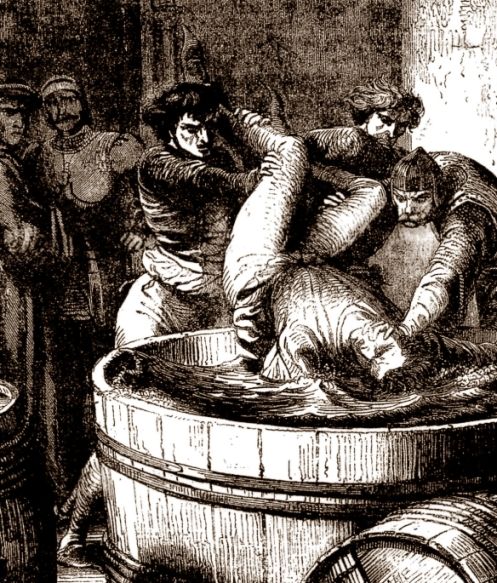 |
| Drowning Clarence in a Butt of Malmsey |
n
n
n
nThe continuernof the Chronicles of Croyland wrote,
n
n
n
n“… execution was delayed for anconsiderable time; until the Speaker of the Commons, coming to the upper housenwith his fellows, made a fresh request that the matter might be brought to anconclusion. In consequence of this, in a few days after, the execution,nwhatever its nature may have been, took place, (and would that it had endednthese troubles!) in the Tower of London, it being the year of our Lord, 1478.”nn
n
nnn
n
nPolydore Vergil, in the History of Richard III,nwrites,
n
n
n
n“ … eaven loe sudaynly he [Edward IV] fell into a fact mostnhorryble, commandyng rashly and upon the suddane his brother George duke ofnClarence to be apprehendyd and put to death, who was drowned (as they say) in anbutte of malmesey; the woorst example that ever man cowld committed remember.”n
n
nnn
n
n
nnn
n
n
n
Lá Fhéile Pádraig Sona Daoibh



















